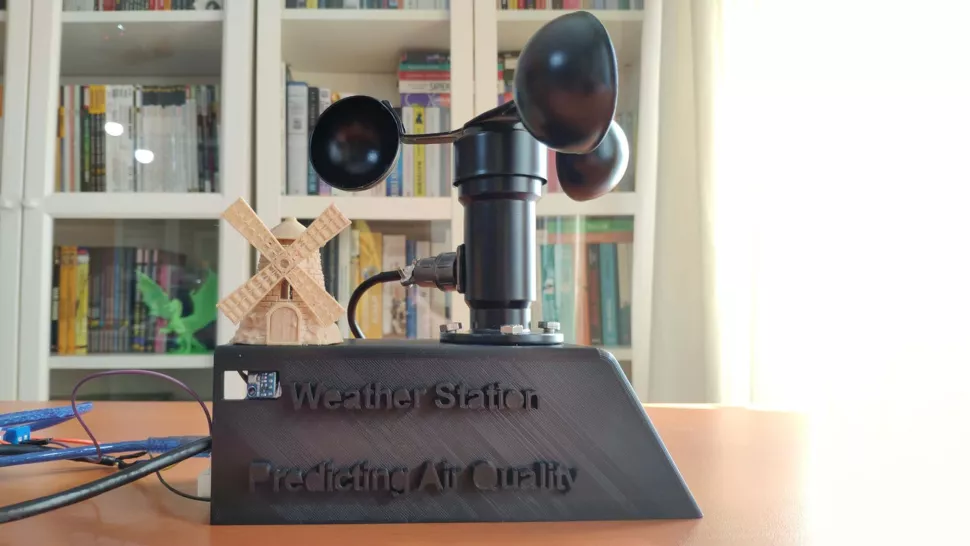A self-taught developer invented an AI weather station that predicts air quality – an important step forward in environmental awareness and climate action.
—
One self-taught developer is making air quality prediction accessible to the masses. Programmer and developer Kutluhan Aktar, a self-taught full-stack developer from Turkey, has used everyday microcontrollers and an AI neural network to create an affordable monitoring and prediction system. The project is open-source, so anyone can use Aktar’s code and 3D-printing templates to make their own. He aims to use his engineering and programming skills to resolve everyday problems with microcontrollers.
Here’s how the AI weather station works and why it’s such an important invention. It could have significant implications on human health and climate change.

An AI Weather Station That Anyone Can Make
Aktar’s AI weather station uses two widely available microcontrollers and an AI algorithm. One-half of the device is an Arduino Nano 33 BLE microcontroller, a small computer chip that’s connected to weather sensors. It’s responsible for collecting outdoor data for the prediction algorithm. It measures several factors, including ozone concentration, temperature and air pressure.
The second half that makes up the weather station is the Raspberry Pi, a single-board computer popular among DIY enthusiasts. The Raspberry Pi and the Arduino Nano are easy to find online or in hobby shops. The Raspberry Pi is where the TensorFlow neural network does all the weather station’s processing. A neural network is a type of AI technology that uses interconnected “nodes” of data to learn and make predictions. They are used in machine learning, such as Aktar’s application.
The weather station’s neural network was trained to make predictions about air quality using a large collection of weather and air quality data. This allowed the algorithm to understand the relationship between them. Comparing current weather conditions to those recorded in the training data allows the AI to predict the air quality. Aktar’s device provides one of three general rankings: good, moderate or unhealthy.
The Importance of Air Quality Prediction
Why make an AI air quality prediction machine to begin with? Creating a sensor by itself is straightforward and doesn’t require an AI algorithm. Aktar wanted to go beyond sensing the current air quality, though, and predict what it would be in the days ahead so he could plan accordingly and potentially avoid outdoor environments. Air quality can significantly impact public health and changes daily with shifts in weather and traffic patterns.
Aktar’s AI system allows users to plan according to local air quality, not just the weather. You can plan indoor activities on days when it’s going to be particularly bad. For example, a school sports coach could use this AI weather station to inform their practice schedule. Poor air quality is more harmful to children and teenagers than adults, especially when it comes to athletics and activities that involve heavy breathing.
Even healthy adults can suffer the side effects of poor air quality, though – particularly those who work outdoors regularly or participate in sports. An elevated heart rate in activities like these results in breathing more air, increasing the harm that polluted air has on the body. For example, ground-level ozone can cause poor lung function, lung inflammation, permanent lung damage, and the development of asthma. Similarly, soot and other particulate air pollutants can lead to chronic lung disease, blood clots, and increased vulnerability to viruses and bacteria.
Aktar’s invention is important because it allows everyday people to understand air quality in their immediate surroundings. Many major cities worldwide have monitoring systems, but this technology hasn’t made its way to smaller cities and towns. Air quality awareness is important everywhere, especially due to climate change.
You might also like: 15 Most Polluted Cities in the World
Climate Change and Air Quality
One of the best things about the AI weather station is that it can help people practice eco-friendly living on a daily basis. Recycling, reducing the use of single-use plastics and walking instead of driving are all great examples. Air quality awareness needs to be part of that list, though. The average citizen may not be able to control air quality in their area, but increased awareness may help spark support for climate action.
Raw data from decades of research shows that the Earth is warming up. That extra heat is mixing with air pollution. This is creating a blanket of ozone much lower in the atmosphere than it should be, which is a danger to public health. Ozone is a gas made of three oxygen atoms that is highly reactive, especially in the presence of heat. It occurs naturally in the atmosphere, but human activity is creating massive amounts of extra ozone, far beyond natural, stable levels. This ground-level ozone is often called smog.
Millions of Americans are estimated to be living in areas with unhealthy levels of ground-level ozone. As of 2019, 54 cities across the US have been recognised for having a significant “ozone problem.” This equates to over 125 million Americans living in US cities that are not meeting the US Environmental Protection Agency standards for ozone levels and air quality.
Aktar’s AI weather station could help millions of people live safer, healthier lives. It may also be crucial to creating climate response policies to address the growing ozone problem worldwide. Massive amounts of data on air quality could be collected as more individuals build their own AI weather stations, including in more remote and economically disadvantaged areas.
Predictions and data from all these stations could offer incredibly valuable insight into the state and future of air quality worldwide. Scientists, policymakers and everyday citizens could use that information to improve air quality and address the health issues connected to it.
Cleaner Air for All
Measuring and predicting air quality will likely become commonplace. Inventions like Aktar’s AI weather station allow anyone to determine how it will be in their area. This open-source invention lets people live healthier lives and be more aware of the air they breathe every day. The world may not have a way to clean the air yet, but the AI weather station is empowering millions of people to increase their air quality awareness.
You might also like: Can AI Help Achieve Environmental Sustainability?
Featured image by: Flickr


















